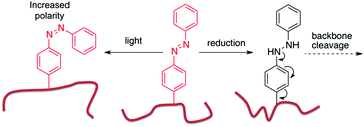Poly(ester amide)s with pendant azobenzenes: multi-responsive self-immolative moieties for modulating polymer assemblies†
Abstract
Azobenzenes are well-known for their trans–cis photoisomerization, but it was recently demonstrated that azobenzene derivatives could also undergo reduction to trigger a 1,6-elimination and initiate depolymerization of a self-immolative polymer. Herein we explore the optimization of azobenzenes as reduction-sensitive moieties, and their incorporation into functional materials. A library of azobenzenes with electron-withdrawing groups was synthesized, and their rates of reduction by hydrazine were determined. Unexpectedly, a 2-Cl substituent increased the rate of reduction more than other electronegative or sterically-demanding substituents. Next, a new diester monomer containing the 2-Cl-azobenzene was synthesized and incorporated into a poly(ester amide) (PEA) backbone, which was then functionalized with PEO to afford an amphiphilic multi-responsive material. The photo- and reduction-sensitivity of the azobenzenes was then exploited to produce reversible and irreversible changes to the polymer nanoassemblies in water. Their responsiveness to light and/or hydrazine was studied by ultraviolet-visible (UV-Vis) spectroscopy, dynamic light scattering (DLS), and fluorescence spectroscopy of encapsulated nile red. Alternating irradiation with UV and visible light resulted in reversible trans–cis isomerization, which changed the polarity of the micelle core without disrupting the assemblies. Reduction by hydrazine resulted in the release of nile red from the micelle core, while residual assemblies were still detected by DLS, likely due to the presence of remaining hydrophobes. A combination of UV light and hydrazine resulted in the release of nile red and breakdown of the assemblies. These results suggest that the intrinsic responsiveness of azobenzene to both light and reductive stimuli can provide polymer assemblies that respond to one or more stimuli in unique and synergistic ways through a single multi-responsive unit.


 Please wait while we load your content...
Please wait while we load your content...